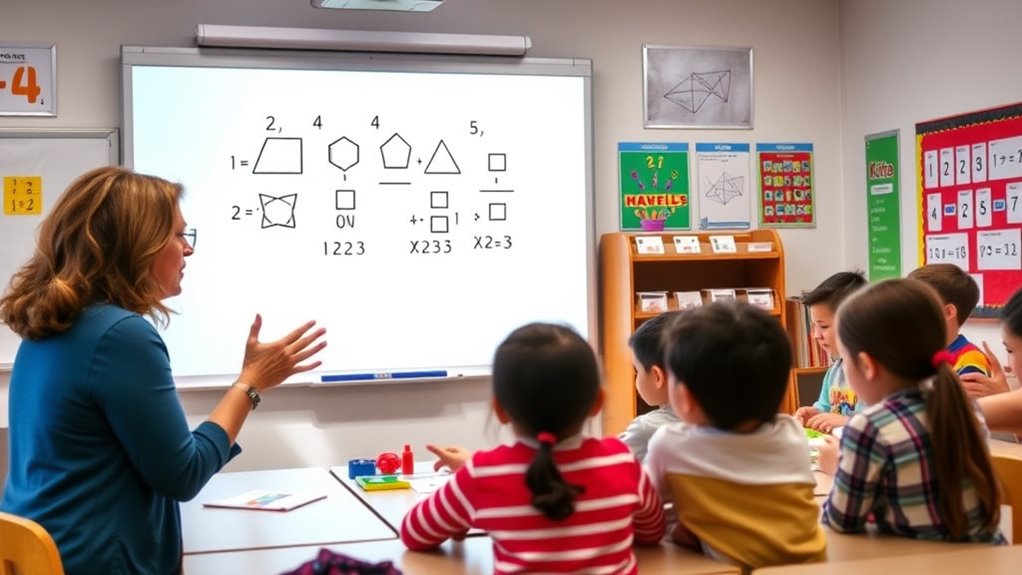To teach math in ASL more effectively than traditional methods, incorporate visual aids like diagrams, models, and digital tools that make abstract ideas more concrete. Engage students with interactive activities such as hands-on problems and group exercises in ASL to promote active learning. Use accessible technology that displays visual content clearly and supports signing. These strategies boost understanding and motivation by making lessons engaging, visual, and tactile—if you keep exploring, you’ll discover even more ways to enhance your teaching approach.
Key Takeaways
- Incorporate visual aids like diagrams, models, and charts to clarify abstract math concepts in ASL.
- Use interactive activities, such as hands-on problems and group exercises, to promote active learning.
- Integrate digital tools and apps with visual and signed features for dynamic, accessible lessons.
- Emphasize multisensory approaches combining visual, kinesthetic, and signed cues to enhance understanding.
- Design clear, high-contrast visual materials and accessible environments to ensure effective communication.

Teaching math in American Sign Language (ASL) offers a unique and effective way to make complex concepts accessible to Deaf and hard-of-hearing students. Unlike traditional methods that rely heavily on spoken explanations and written text, using visual aids and interactive activities helps bridge the communication gap and makes learning more engaging. When you incorporate visual aids, you tap into students’ visual learning strengths, allowing them to see abstract concepts like fractions, algebra, or geometry in a concrete form. For example, using diagrams, charts, and physical models, you can demonstrate how numbers relate to each other, making these relationships clearer and easier to grasp. Visual aids also serve as universal tools, reducing misunderstandings that can occur when relying solely on verbal explanations.
Interactive activities further elevate your teaching approach by actively involving students in the learning process. Instead of passively watching or listening, they become participants, which boosts retention and understanding. For instance, you might use hands-on problems where students sign or gesture to demonstrate solutions, fostering a kinesthetic learning experience. Incorporating games, puzzles, or group exercises that require the use of ASL helps reinforce mathematical concepts while keeping students motivated. These activities also encourage peer collaboration, allowing students to communicate their reasoning and learn from one another in a supportive environment.
You can also leverage technology to create interactive lessons that combine visual aids and ASL. Digital tools, such as interactive whiteboards or apps with visual and signing components, make lessons dynamic and customizable. For example, you might display a problem on a screen, then guide students through solving it using visual cues and signed explanations. This approach not only makes abstract ideas more tangible but also caters to different learning styles. The key is to guarantee that these tools are accessible and designed with ASL users in mind, so students can fully participate and benefit. Additionally, understanding the importance of contrast ratio in projectors can help create visual environments that enhance the clarity of visual aids used during lessons.
Frequently Asked Questions
How Do Visual Aids Enhance Math Learning in ASL?
Visual aids greatly enhance math learning in ASL by providing clear visual representation of abstract concepts. You can use interactive models to make lessons more engaging, helping learners grasp complex ideas more easily. These tools facilitate better understanding, especially for visual learners, by making the information more concrete. Incorporating visual aids in your teaching allows students to connect symbols and operations, boosting their confidence and retention in math.
What Challenges Do Deaf Students Face in Math Education?
When considering the challenges deaf students face in math education, you recognize that limited sign language fluency can hinder understanding of complex concepts. Additionally, a lack of cultural awareness may lead to misunderstandings or feelings of exclusion. You need to guarantee accessible communication and foster an inclusive environment, so students can fully grasp math ideas. Addressing these issues helps improve their learning experience and promotes confidence in their abilities.
Are There Specific ASL Signs for Complex Math Concepts?
You might wonder if there are specific ASL signs for complex math concepts. Yes, there are signs for derivatives and other advanced topics in ASL math vocabulary. These signs help you communicate intricate ideas clearly and effectively. Learning these signs allows you to grasp and share complex math concepts more easily, making math education more accessible and engaging for deaf students. Mastering ASL math vocabulary enhances understanding and fluency in advanced mathematics discussions.
How Can Teachers Assess Math Understanding Through ASL?
Imagine your students’ understanding shining like a beacon in the night. To assess their math grasp through ASL, you rely on gesture recognition and sign consistency. Watch their signs closely, noting if they’re using the correct gestures and maintaining consistency. This visual feedback acts as a mirror, revealing their comprehension. By combining these cues, you can gauge where they shine and where they need a little more guiding light.
What Technology Tools Support Teaching Math in ASL?
You can enhance your teaching of math in ASL by using assistive tech and digital resources. Tools like interactive whiteboards, math-specific apps, and video platforms support visual and hands-on learning. These technologies make complex concepts clearer, allowing you to demonstrate problem-solving steps in ASL. By integrating digital resources, you create an engaging, accessible environment that helps students understand math more effectively and confidently.
Conclusion
Just like a skilled navigator uses a compass to chart unfamiliar waters, embracing innovative ASL math strategies guides you beyond traditional methods. These approaches act as your lighthouse, illuminating new paths and helping you reach understanding more clearly. Keep exploring, adapting, and trusting your tools. With each step, you’ll steer closer to empowering your students, proving that with the right strategies, you can turn even the most complex concepts into clear, navigable seas.











